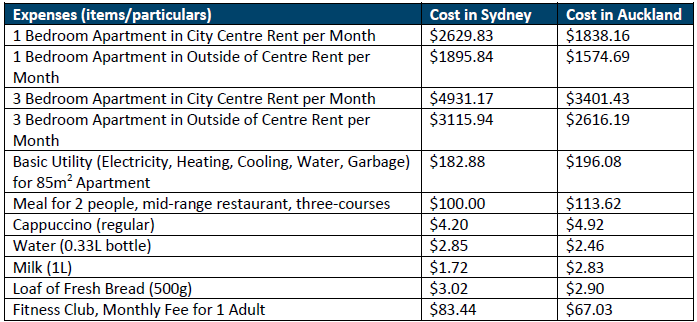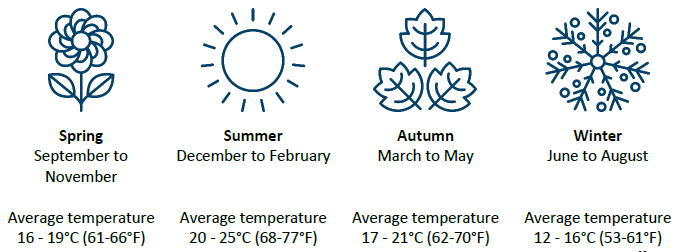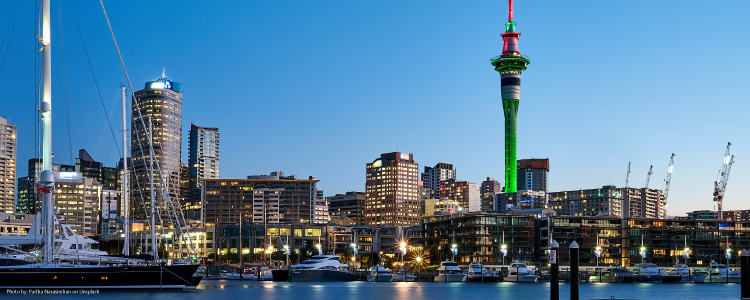Recently named the world’s most liveable city in the world, Auckland is a modern and relaxed city sandwiched between the Tasman Sea and the Pacific Ocean. Locals are spoilt with breathtaking scenery, great year-round weather and scrumptious food and wine options.
As of 2018, 1.5 million2 people call Auckland home, of which 53.5% are of European descent, 28.2% are Asian, and 13.2% are of Maori descent. This cultural mix creates a vibrant and diverse atmosphere that separates Auckland from other cities in New Zealand and makes it a more desirable destination for expats and migrants. There are over 200 suburbs which means you can choose a neighbourhood that suits your lifestyle. In addition, the simple and straightforward visa process makes it an attractive relocation destination for Australians.
Visas
If you’re an Australian citizen or permanent resident and you’re thinking of moving to Auckland, we got good news for you! You don’t need to apply for a visa to live and work in New Zealand, as you may be granted what’s called an ‘Australian Resident Visa’ upon arrival at the border. The Australian Resident Visa allows Aussies to “visit, live, work and study in New Zealand” indefinitely, as long “as you meet the character and entry permission.”3
If you’re entering New Zealand from a different country, make sure you visit New Zealand Immigration for more information.
Healthcare
Another perk of being an Australian citizen or permanent resident living in Auckland is healthcare.
“New Zealand has reciprocal health agreements with Australia and the United Kingdom (UK)”4.
Under this agreement, Australian citizens and permanent residents are covered by the New
Zealand/Australia Reciprocal Health Agreement if they:
- “Are on a temporary visit (up to two years long) to New Zealand AND
- in the opinion of the provider of medical treatment, need immediately necessary medical treatment while in New Zealand.
They:
- will get the same treatment as an eligible person gets
o IF that treatment is clinically necessary for the diagnosis, alleviation or care of the condition requiring attention - including pharmaceutical benefits, hospital services, and maternity services.”4
To find out what’s available to you, visit the Ministry of Health page.
Employment
Before you start working in New Zealand, don’t forget to:
- Get a tax number also known as an IRD – this allow you to earn money from a job, benefit or pension. You can also use it to apply for child support and file tax returns5.
- Read and learn about KiwiSaver – KiwiSaver is a “voluntary, work-based retirement savings scheme.”6 Australians citizens and permanent residents are eligible for KiwiSaver as long as they live in New Zealand. Plus, you can also transfer your KiwiSaver fund into an Australian super fund, if you decide to return to Australia. To learn how visit this page.
- Set-up a local bank account – You may choose to open a local bank account if you wish, the top 5 banks in New Zealand are ANZ, ASB, Bank of New Zealand, Kiwibank and Westpac New Zealand.
Job Boards
If you want to search for current opportunities in Auckland, we recommend visiting Seek and
TradeMe, 2 of New Zealand most popular job boards.
Industries
Auckland is New Zealand’s powerhouse when it comes to economy. The region generates nearly
40% of the country’s GDP and “is home to 36% of the country’s workforce.”7 The Commercial
Services sector has the highest number of employees with almost 200,000 individuals, followed by
Construction and Engineering at 109,136 and Technology at 68,638 staff.8
School structure
In New Zealand, there are 13 ‘years’ in the school structure. The ‘year’ indicate how long a child has
been at school. In addition, schooling is divided into 3 stages – Primary, Intermediate and Secondary.
Schooling begins at primary school starting at Year 1. “Children can attend either a contributing
primary school or a full primary school. Contributing primary schools are more common than full
primary schools”9.
- “Contributing primary schools go from Year 1 to Year 6.
- Full primary schools go from Year 1 to Year 8.”9
Full primary schools go fro
From there, your children will need to attend a secondary school or an intermediate school,
depending on whether they attended a contributing primary school or a full primary school.
Secondary schools go from Year 9 to Year 13.
Types of Schools
There are 3 types of schools in New Zealand, they are:
- State schools – owned and funded by the NZ government
- State Integrated Schools – similar to state school but they may also charge a fee and are usually schools with a ‘special character’. “This means they may be run by a particular religious faith, e.g. Catholic, or use specialise education methods, like Steiner and Montessori school.”9
- Private Schools – charge fee for a set term or the entire year
Most children attend a state school as known as public school, which are free to all domestic
students. Domestic students include New Zealand citizen, New Zealand resident as well as Australian
citizens and permanent residents.
School Terms
There are 4 terms in a year, 2-week break in between Terms 1-3- and 6-week summer break after
Term 4. Term periods below:
- Term 1: late January to early April
- Term 2: May to early July
- Term 3: late July to late September
- Term 4: mid-October to mid-December
A school day usually start at 9:00am and ends at 3:00pm or 3:30pm, depending on the school.
Higher Education and Post-high school training
If your children have graduated from high school and are wondering what they want to do post-high
school, they can choose from the following:
- Universities – The University of Auckland was ranked number 1 in the country in 202010 and placed 85th in the world11, so you can be sure that your children will find course they want to study and a career they can pursue. Your children can also enroll in Massey University, Auckland University of Technology and the Manukau Institute of Technology.
- Vocational training – to train at a specific trade, job or profession
- Apprenticeship – a formal arrangement that provides young adults with an ability to earn whilst learning from an expert
- On-the-Job training – to learn as they work
The location of your new home will depend several factors – your lifestyle, the whereabout of your
new workplace and your situation. If you’re single, looking for an adobe that’s closer to the Central
Business District (CBD) and don’t mind commuting, then Central Auckland, Ponsonby and Parnell
might be a good choice for you. Central Auckland is known for its social, cultural and business scene,
Ponsonby has an edgy and bohemian vibe, whilst Parnell is ideal for those who are looking for
quieter and slower phase.
If you’re moving to Auckland with your family, then Devonport, Takapuna, Howick and Grey Lynn
are ideal neighbourhoods for families. These suburbs are closed to schools, of easy to distance to
Auckland’s CBD and has plenty of shops, food and wine options and recreational activities to keep
everybody occupied.
Again, this will depend on your circumstances and how long you’re planning on staying in Auckland.
If you’re keen in making Auckland your permanent home, then buying maybe a more practical
approach. However, if you and your family plan to stay in Auckland for a set period then renting may
be more beneficial for you. Auckland properties are typically priced on a per week basis and you’re
usually required to provide a bond or deposit, usually up to 4 weeks. Also, your landlord can ask for
1 to 2 weeks’ rent in advance depending on your payment terms12.
According to Crockers Property Management, rental prices for a 1-bedroom property in Auckland’s
city centre (Parnell, Grafton and Newton) is $391 per week, while a 3-bedroom property in the same
area will cost you $801 per week13. The cheapest neighbourhood is Papakura, a southern suburb,
approximately 32 kilometres away from Auckland CBD. Rent here ranges from $283 to $691 per
week depending on the number of bedrooms. While rental prices in Ponsonby can range from $518
to $1,189 per week.13
Cost of living
According to Numbeo, the cost of living in Auckland for:
- “Family of four estimated monthly costs are 5,127.82A$ (5,415.98NZ$) without rent
- A single person estimated monthly costs are 1,414.20A$ (1,493.67NZ$) without rent.
- Auckland is 3.95% less expensive than Sydney (without rent)
- Rent in Auckland is, on average, 24.81% lower than in Sydney.”14
Below is cost comparison of Sydney and Auckland’s food, utilities and rental prices. Data attained
from Numbeo.15 Prices are in Australia Dollars:

Overall, Auckland is cheaper than Sydney in terms of Rent and Sports & Leisure. However, when it
comes to food and utilities, Auckland is slightly more expensive compared to Sydney.
Getting around Auckland is easy, fast and pocket friendly, particularly if you live within the city
centre as there are plenty of forms to choose from. However, if you decide to move outside the city
centre, then expect longer commute times and many cases you will need your own vehicle to
transport to-and-fro your destination.
Public Transport
So, what public transport is available to you? You can take the train, ferry or bus to take you to your
new workplace, shopping centres and major attractions. Britomart, located in downtown Auckland,
is the city’s equivalent of Sydney’s Central Station and Melbourne’s Flinders Street. Majority of bus
and train journey start and finish at Britomart, and Auckland Ferry Terminal, also known as the
Downtown Ferry terminal is a quick, 2-minute walk from Britomart.
CityLink Buses
Auckland also has CityLink buses to make it easier to travel within the city. It’s InnerLink buses (green
buses) travels to Parnell and Ponsonby, while its OuterLink (amber buses) travels to universities,
Herne Bay, Parnell and Mt Albert. The blue CityLink buses travels to Auckland’s Eastern Bay and its
red buses “operates from the newly developed Wynyard Quarter, along Queen St, up to
Karangahape Road and then back down Queen Street”16.
AT HOP card
Before you hop on a bus, ferry or train at Auckland, make sure you purchase an AT HOP card, which
is a “reusable prepay smart card for travel on trains, ferries and buses around Auckland”17. You can
buy a card online, at train stations and selected retailers.
Driving
If you wish to drive in Auckland, you can use your existing driver’s license or apply for International
Driving Permit. Your driver’s license or International Driving Permit is valid for 12 months, but, “after
12 months you are required to convert to a New Zealand license. This applies to each visit to New
Zealand”18.
What side of the road do Kiwi’s drive on? New Zealanders drive on the left-hand side of the road and
drive right-hand drive cars just like the UK, Australia and Japan. “Roundabouts or turning circles are
driven clockwise, not anti-clockwise”18.
Vehicle Transportation
If you wish to take your vehicle with you to Auckland, then contact Grace and find out how we can
transport your car, van, boat or motorcycle for you. Our stress-free vehicle transfer service is
tailored to meet your needs. We will ensure that your vehicle is safe and secure throughout its
entire journey and will coordinate all aspects of the vehicle relocation for you. To learn more, go
here.
Locals enjoy “a warm, coastal climate without any extreme in temperature”19. However, it can be
changeable due to weakening cyclones and cold fronts. We recommend you prepare for “four
seasons in one day”19 and to pack a hat, sunscreen during spring and summer to protect yourself
from New Zealand’s high UV rating.
Seasons
Auckland’s wettest month is July with approximately 60mm of rain. Overall autumn and winter
months tend to be wetter than summer months20.

There are plenty of reasons why Auckland was ranked the most liveable city in the world and why is
a go-to destination for visitors and expats. The city is diverse, thriving and there are plenty of
activities and events to enjoy, this includes the Auckland Festival, The New Zealand International
Comedy Festival and New Zealand International Film Festival.
Sport is major pastime for locals and Cricket and Rugby Union is extremely popular with a host of
grounds within the city. In addition, “tennis, netball and football are also popular in city and there
are many opportunities to watch and participate in all of these sports.”21
If you’re an art fanatic, then you’ll love the Auckland Art Gallery, “which houses over 15,000 works
of art”. Also, “the city regularly hosts the New Zealand Symphony Orchestra and the Royal New
Zealand Ballet”21.
Recreation
Locals are spoilt when it comes to things to do in Auckland. The city is surrounded by volcanoes, twin
harbours and native rainforests, meaning there are plenty of hiking routes, walking tours, island
hopping and water activities to enjoy. There are plenty of wine and dine options including Waiheke
Island, an island filled with vineyards, olive groves and beaches and is short 40-minute ferry ride
from downtown Auckland22.
1 Hardingham-Gill, 2021, The world’s most liveable cities in 2021
2 Stats NZ, n.d., Auckland Region
3 New Zealand Immigration, 2021, Information about Australian Resident Visa
4 Ministry of Health – Manatu Hauora, 2021, Reciprocal health agreements
5 New Zealand Government, 2021, How to get an IRD number
6 Inland Revenue, 2021, KiwiSaver
7 Auckland Unlimited, n.d, Business
8 Auckland Unlimited, n.d., Sectors of focus: employment
9 New Zealand Immigration, 2020, The School System
10 Collier, S., 2021, Top Universities in New Zealand 2020
11 The University of Auckland, n.d., New Zealand’s world ranked University
12 New Zealand Immigration, 202, Renting a house
13 Crockers Property Management, 2021, Auckland Rental Prices October 2021
14 Numbeo, 2021, Cost of Living in Auckland
15 Numbeo, 2021, Cost of Living Comparison Between Sydney and Auckland
16 Auckland Transport, 2021, Link Bus Service
17 Auckland Tranport, 2021, What is an AT HOP card and how it works?
18 DT Driver Training, What side on the road do we drive on in New Zealand?
19 New Zealand Tourism Guide, Auckland Weather and Climate
20 Holiday-weather.com, 2021, Auckland, New Zealand: Annual Weather Averages
21 Internations, 2021, A comprehensive guide about living well in Auckland
22 newzealand.com, n.d., Waiheke Island


